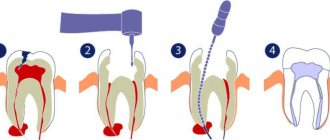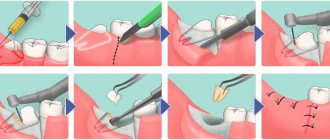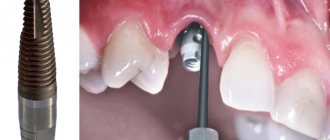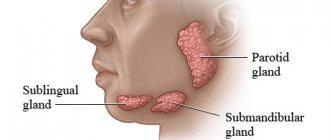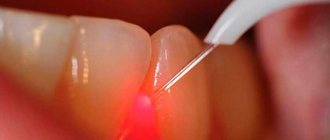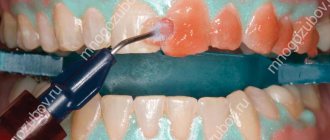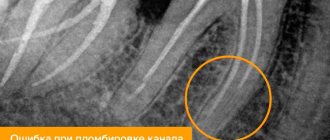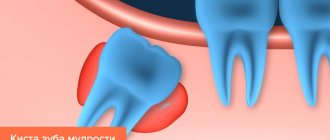Many dental diseases develop latently for quite a long time and, like many other diseases, in the first stages of development they are easily and simply controlled, for example cysts, which can be easily treated with conservative and non-surgical methods, the main thing is not to let the problem take its course.
The main problem of diagnosis and timely dental treatment is that patients, who remember what dentistry was like in the USSR, prefer to endure and ignore the initial symptoms “until the last” and turn to the dentist after the development of complications or already in advanced situations, when without surgical intervention not enough.
In addition, there are a number of diseases that appear and develop without pain or discomfort, asymptomatically, and therefore are discovered completely by chance on an x-ray or already at the stage when there are visible signs of inflammation and the preservation of the tooth becomes doubtful. Such dangerous and hidden pathological processes include a dental cyst, which does not manifest itself in any way, is detected by chance and so surprises patients with completely unexpected worries and expenses.
What is a tooth root cyst?
A cyst is an advanced form of inflammation of the tooth ligament.
There are several types of jaw cysts, but the most common is odontogenic, i.e. tooth root cyst. We will talk about it in this article.
It is of an infectious-inflammatory nature, i.e. is a consequence of “no treatment” or poor treatment of the tooth.
Translated from Greek, “cyst” means “bubble”. Morphologically, it is a cavity with a fibrous wall and contents. Simply put, a sac under problem roots filled with inflammatory fluid (for example, pus). Its dimensions vary from a few millimeters to several centimeters. The cyst that appears is attached to the apex of the tooth root and is located in the periodontal space - between the root and the bone tissue.
The X-ray image shows an area of bone tissue destruction (a large “dark cavity” adjacent to the root of the tooth). This is a cyst.
The reasons for its occurrence
- previously suffered: sinusitis, tonsillitis, rhinitis, previous diseases not treated by dentists;
- mechanical injuries;
- eruption of wisdom teeth;
- the presence of caries, periodontitis.
The appearance of formation is promoted by: hypothermia, weakened immunity.
Untimely treatment of a cyst on the root of a tooth can lead to consequences: tooth loss, the occurrence or complication of sinusitis, and an abscess.
Diagnosis is carried out using an x-ray.
Why does a cyst occur?
Most often, a cyst is associated with an infection in the canals of the tooth. If caries and its complications (pulpitis, periodontitis) are not treated promptly, then microorganisms (bacteria, viruses, etc.) that live in the root canals of carious teeth sooner or later penetrate into the surrounding bone tissue. The body of a healthy person builds a barrier against microflora, which is the shell of the cyst. In this way, it tries to localize and isolate pathogenic microbes, preventing them from spreading further. The cyst zone is nothing more than the front line in which the body fights the infection, and military action is the infectious inflammatory process.
As long as the infection persists, that is, as long as the body has someone to fight with, the cyst will exist and grow.
Other causes of dental cysts may be:
- Tooth injury.
- Incompetent treatment of the root canals of the tooth, namely poor-quality mechanical and medicinal treatment of the canals or poor-quality filling of the canal (in particular, loose filling, with voids that are very quickly filled with bacteria, which can ultimately lead to a dental cyst.
Removal of upper teeth
The bone of the upper jaw is somewhat softer than the lower jaw.
The units are positioned straighter and are easier for the surgeon to grasp. Therefore, removal of the upper molar in many cases is faster and less painful. Patients are often frustrated by the need to have their front teeth removed. The smile zone is always visible, so the absence of one brings a negative attitude and leads to a decrease in self-esteem. But today such an operation is not scary. There are every opportunity to quickly restore the integrity of the dentition.
Removing the front tooth on the upper jaw is simple - it has only one cone-shaped root and is located conveniently for manipulation. The operation will take about 20 minutes, including waiting for the anesthesia to take effect. If there are no contraindications, then simultaneous implantation is recommended - the destroyed unit is removed and an artificial root is immediately installed in the same hole.
Our clinics employ implantologists who are proficient in advanced techniques and have completed internships in foreign clinics. Only premium implants are used. Therefore, you will quickly gain a new beautiful smile. It is possible to install a temporary plastic crown on the pin on the day of removal. The front teeth will be in place, and no one will notice the changes.
Treatment from world-class doctors cannot be cheap, but we have found an opportunity to make help accessible - we treat immediately, and offer to pay for services in installments in convenient amounts, without charging interest.
Removing the upper root of a tooth is a more complex process. The root branch is drilled into several parts, which are removed step by step. This procedure for intervention is typical for molars and wisdom teeth, when the walls have completely crumbled and the root is also not viable.
How does a cyst manifest itself?
The insidiousness of a dental cyst lies in the fact that its appearance at first is almost asymptomatic. It makes itself felt when the purulent sac has already reached a fairly large size. Exacerbation of inflammation and the manifestation of cysts occurs when the immune system is weakened. It is often learned about during acute respiratory viral diseases, when the body weakens due to the fight against the disease. So, we list the possible symptoms of a dental cyst:
- acute toothache appears;
- swelling and swelling of the gums and cheeks;
- increased body temperature;
- weakness;
- general malaise;
- a fistulous tract may appear on the gum, through which pus from the cyst will enter the oral cavity;
- absence of visible symptoms (the cyst does not manifest itself in any way and is discovered by chance on x-rays).
If outwardly the tooth looks completely healthy and the patient does not experience any discomfort or pain, this does not indicate that the tooth is healthy. A cyst is one of the pathologies that does not always occur with any clinical manifestations. However, the consequences can be quite dire, both for the tooth itself and for the tissues surrounding it.
A dental cyst is diagnosed based on the results of radiography. On an x-ray, it looks like a dark spot at the apex of the root, in other words, like a black ball. Sometimes pathology is discovered completely by accident, when examining a neighboring tooth or during a routine preventive examination at an appointment with a dentist or ENT doctor during an examination of the maxillary sinuses.
An x-ray of all teeth (orthopantomogram) shows a zone of bone tissue destruction (“black ball” adjacent to the root of the tooth). This is a cyst.
How to treat a tooth with a cyst?
There are 2 fundamentally different ways to treat dental cysts:
Therapeutic and surgical.
- Therapeutic method : treatment of tooth canals, as a result of which the cyst disappears. As a rule, it takes several visits to the doctor, ranging from 2 weeks to six months.
It is carried out by a dentist-therapist, whose main task is to remove the infection from the root canals, that is, to eliminate the factor supporting the cyst. After root canal treatment, temporary medications are left in them, which act on the cyst and contribute to its regression and complete disappearance. At the end of treatment, the root canals are filled with permanent materials and the damaged tooth is restored. Subsequent dynamic monitoring of the tooth is also necessary, which consists of visiting the dentist every six months, and X-ray monitoring.
- The surgical method is to remove the tooth root cyst. It is used when the therapeutic technique is ineffective.
There are 2 types of surgical techniques:
- Removal of the cyst, preserving the causative tooth.
- Removal of the cyst along with the causative tooth.
Preserving a tooth is advisable only if the causative tooth is not severely damaged and does not cause inflammation in neighboring organs and spaces.
The cyst is removed by a dental surgeon under local anesthesia.
Conservative treatment methods
The therapeutic option for treating dental cysts is lengthy and complex, but it is still practiced in dentistry. The conservative treatment algorithm is as follows: ALL WORK IS CARRIED OUT UNDER A MICROSCOPE!
- The first stage is to work with root canals, their immediate sterilization. There may be two therapeutic solutions here. If the canals have been sealed, then they are unsealed and re-treated.
- Repeated flushing of the canals with an antiseptic is mandatory, since the cyst has purulent contents.
- Specific dental techniques are performed to remove the medication beyond the root apex.
- The doctor performs a temporary filling of the canals with a special paste that contains an antiseptic. This and the previous stages of treatment are repeated several times.
- The patient takes an x-ray, which is used to evaluate the dynamics of treatment. If its signs are positive, therapy continues. Otherwise, they proceed to surgical procedures.
- Treatment is carried out over several months with periodic radiological assessment of the reduction in cyst size. Only when it is significantly reabsorbed is the final filling of the canals performed.
- The final stage is filling the tooth.
Therapeutic treatment is advisable only if the size of the cyst does not exceed 10 mm.
How to choose a cyst treatment method? Who chooses it and what does it depend on?
The choice of treatment method for the cyst is made by the dentist, according to the specific clinical situation. The method depends on:
- preservation of tooth tissue (if the tooth cannot be restored after treatment of the cyst, choose a surgical method with removal of the cyst);
- on the anatomy of root canals and the ability to process them efficiently;
- from the availability of good equipment and equipment in the clinic (for example, a dental microscope, etc.), which allows you to go through root canals and process them efficiently;
- on the patient’s health and the presence of chronic diseases;
- on the duration of existence of the cyst;
- on the skills of a particular specialist.
How successful is the prognosis for treatment of cysts and what does it depend on?
Surgical and therapeutic methods of treatment give excellent results, provided they are performed correctly and with high quality.
The success of treatment (and this is what we call the preservation of the causative tooth and the complete disappearance of the cyst) also depends on the following factors:
- on the anatomy of root canals and the ability to process them efficiently;
- from the availability of good equipment and equipment in the clinic (for example, a dental microscope, etc.), which allows you to go through root canals and process them efficiently;
- on the patient’s health and the presence of chronic diseases;
- duration of existence of the cyst;
- on the skills, abilities and experience of a particular specialist.
What happens if a tooth with a cyst is not treated? What's wrong with a cyst? Consequences of a tooth root cyst
- The cyst is prone to growth, and as it grows, it destroys the surrounding bone and disrupts anatomical formations (for example, the lower wall of the maxillary sinus, provoking the development of sinusitis, etc.).
- The cyst can fester, and the inflammatory process spreads into the surrounding spaces, causing serious complications that threaten the patient’s life (abscesses, phlegmon, etc.).
- As the cyst grows, it can push away neighboring teeth and significantly change their position.
- The cyst can lead to a pathological fracture of the jaw if it reaches a very large size.
- The cyst can eventually lead to tooth loss.
After treatment of a cyst, the tooth hurts, is this possible? And if so, what time is considered the norm?
Of course, immediately after treatment the tooth may bother the patient, this is natural. However, this does not always happen.
Normally, after treatment of a tooth with a cyst, the tooth either does not hurt at all or bothers you for 1-2 days.
If after dental treatment the pain persists and does not decrease for more than 2 days, we advise you to inform your doctor about this.
During treatment, an exacerbation of the inflammatory process may occur, which passes over time and this does not mean that the treatment is unsuccessful. The presence of an exacerbation depends on how aggressive the microbial flora lived in the root canal and on the patient’s immune strength.
Pain after treatment is stronger if the tooth began to be treated during an exacerbation of the inflammatory process. Therefore, our advice to you, dear patients, is not to let it get to the point where pain occurs (as most people mistakenly do). Start treatment while nothing hurts, during a calm period. It will be easier for you, and there may be no pain at all after the intervention.
Advantages and disadvantages of laser treatment
Laser cyst removal has a number of advantages, which are the reason for the growing popularity of the technique. These include:
- Beautiful name.
- Novelty of technology.
- There is no need to use additional antiseptics, since the laser sterilizes well the points it hits and copes with sanitation (although the number of relapses casts doubt on this advantage).
- There is no risk of complications common to surgical interventions, including bleeding.
- The hope is to preserve the natural tooth (however, if the cyst recurs, there is a high probability of losing it).
We must not forget about the disadvantages of the technique, which, at first glance, are fewer than the advantages, but they are quite significant. First of all, the cost of the procedure will be an unpleasant surprise for patients. High prices for laser cyst removal are due to significant interest and demand for alternative offers, but you don’t want to remove a tooth, patients are “grasping at straws.” The effectiveness of laser treatment is still in doubt, especially in cases of significant size of the cyst and its close proximity to the tooth tissue. The patient should think several times before agreeing to such treatment for the disease. Moreover, in case of failure, the dentist returns to traditional surgical techniques, and in some situations removes the cyst along with the affected tooth.
!Important: before starting treatment, draw up a full turnkey estimate, carefully read the contract and the clinic’s warranty for such procedures; it is often easier and cheaper to replace a tooth with a cyst with an implant than to prolong its agony and believe in miracles for money without a guarantee.
